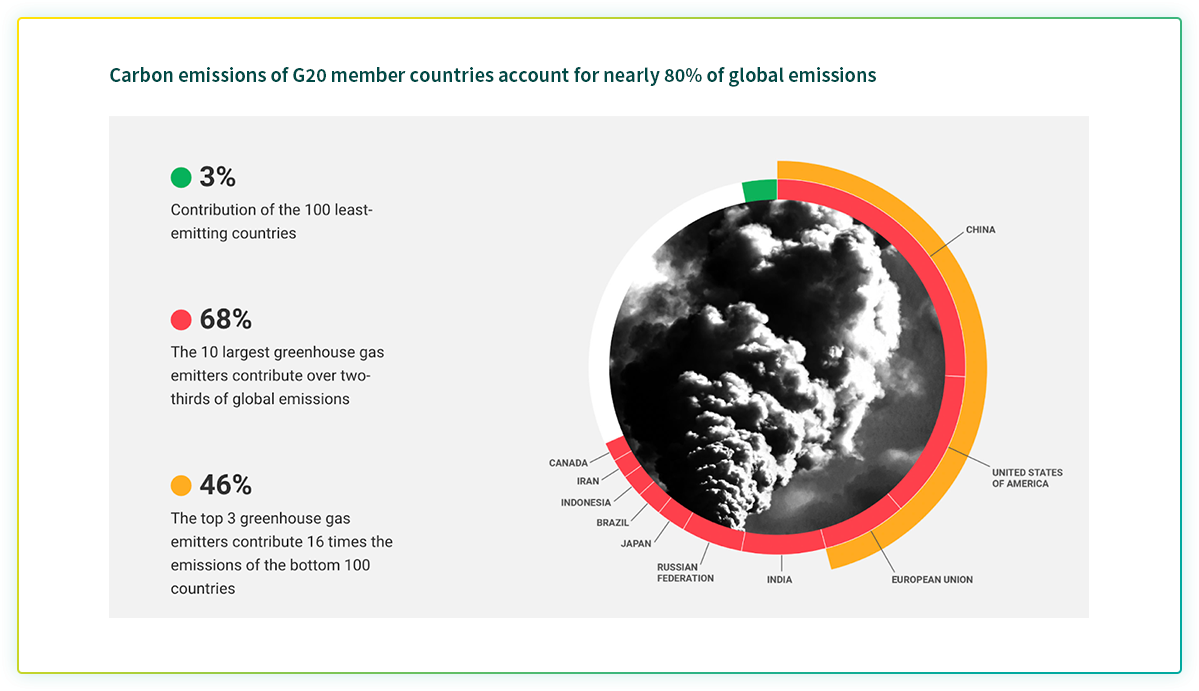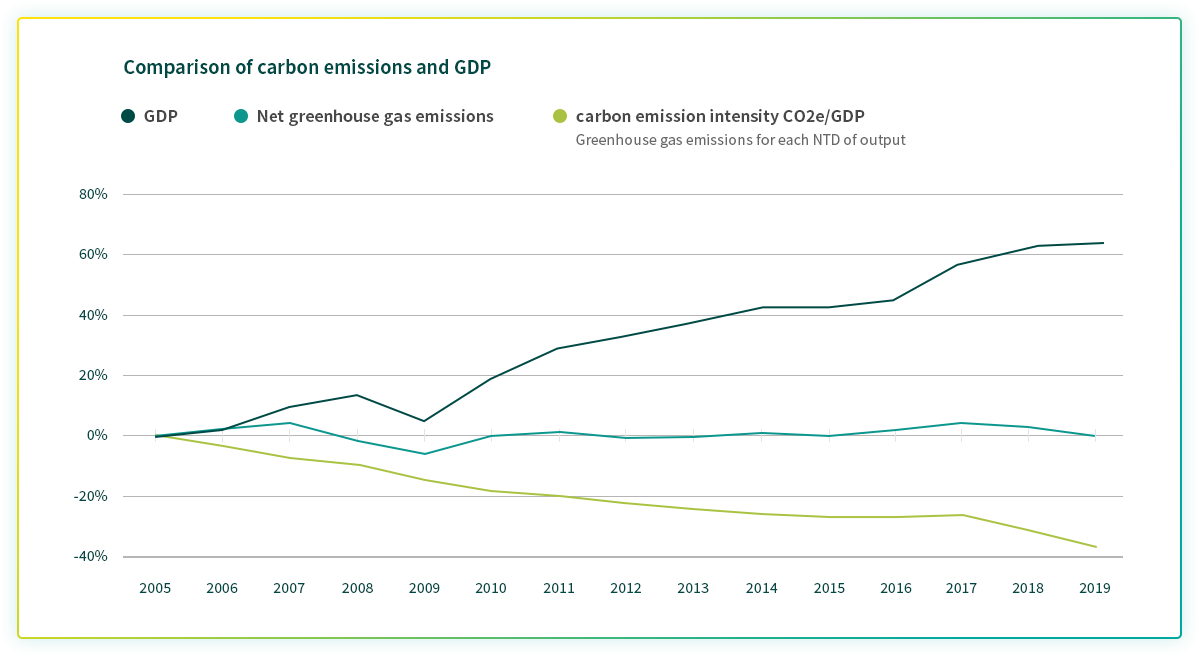Introduction: Pressing climate challenges: More than 70 countries have pledged to achieve net zero emissions by 2050
Relevant scientific evidence has constantly shown that greenhouse gas concentrations in the atmosphere are increasing, and will eventually cause extreme global climates and environmental issues, which in turn will affect the habitability of the Earth.
Evolution of civilization in the modern era has caused overall temperatures on the Earth to rise by around 1.1 degrees Celsius compared with the late 1800s. In 2022, the United Nations stated that global warming would continue to increase by 1.5 degrees Celsius within the next 20 years (Note 1), which will undoubtedly have a severe impact on biological environments, water resources, and even food security issues linked to human survival.

Observations of total global greenhouse gas emissions show that the countries with the top ten levels of emissions account for two-thirds of global emissions (Note 2), indicating that effective reduction of emission levels in these countries will be a stepping stone in solving climate warming problems.
Source: United Nations.
There are many reasons why there is urgent need for change. The United Nations continues to call on the international community for immediate reduction of carbon dioxide, methane, and other greenhouse gas emissions that can cause warming. More than 70 countries around the world have pledged to halve greenhouse gas emissions by 2030 and plan to achieve net zero emissions by 2050.
“Net zero emissions” does not refer to complete elimination of greenhouse gases, but rather changes in industrial production processes and transportation to bring greenhouse gas emission levels as close to zero as possible, ensuring that excess emissions can be absorbed and neutralized by oceans, forests, and natural environments.
Taiwan works to decouple economic development from carbon emissions amid increases in global greenhouse gas emissions
Current climate plans of various countries cannot hope to achieve 2050 net zero emissions goals, and greenhouse gas emissions are still continuing to rise. It is estimated that emissions may increase up to 14% by 2030 (Note 3).
Even though global greenhouse gas emissions are continuing to increase rather than decrease, the concept of net zero emissions, which will greatly impact future generations, has always been a part of Taiwan’s overall development goals. Contrary to international trends, total greenhouse gas emissions in Taiwan continue to decrease (Note 4), which is very commendable. Total carbon emissions in 2019 were 287.06 MtCO2e, a reduction of 1.1% compared with 2005.

Another noteworthy point is that Taiwan’s GDP increased by 64% during the process of regulating greenhouse gas emissions from 2005 to 2019, carbon emission intensity (CO2e/GDP) has decreased by 34%, and net greenhouse gas emissions are also decreasing gradually. Various signs show that Taiwan’s economic growth is not linked with greenhouse gas emissions.
Source: National Development Council “Taiwan’s Pathway and Strategies to Net-Zero Emissions in 2050”
Why is it that Taiwan can make strides toward the vision of net zero emissions?
The main reason is that the Taiwanese government incorporated net zero emissions into policy goals from an early stage, emphasizing circular economy, energy savings, and carbon reductions; implementing standards to enhance energy efficiencies of home appliances; and electrifying public transportation while simultaneously providing a series of corporate energy transformation guides and subsidies.
Transforming waste to energy: “Net zero emissions” is more than just a slogan
As the city with the fastest population growth in Taiwan, Taoyuan City incorporated sustainable development concepts into municipal plans from a very early stage, seeking to meet the ambitious goals of global environmental sustainability while pursuing local economic development.
Taoyuan City Government knows that in order to achieve net zero emissions, it is necessary to “transform waste into energy.” Therefore, Taoyuan City announced the initiation of the “Taoyuan Net Zero Strategy” starting in 2019. The most important strategy under this program was the reduction of industrial fossil fuel usage through subsidies and guidance for corporations. Waste is made into Solid Recovered Fuel (SRF) after processing, reducing air pollution levels to 33% of that for fossil fuels, decreasing fossil fuel usage and carbon emissions.
For example, Taoyuan City assisted Yuen Foong Yu Packaging Inc. in establishing a “Solid Recovered Fuel (SRF) manufacturing and utilization plant,” which later became the “Taoyuan City Waste MT Demonstration Center.” The plant can process more than 80 tons of waste a day, transforming waste plastics, large furniture items, and other waste into RDF-5 and wood-based fuels, replacing coal used in boilers, thereby transforming waste into energy.
In terms of other net zero emissions achievements, Taoyuan City also led other regions in Taiwan in establishing the first biomass center with mechanical waste sorting, SRF plants, and reused kitchen waste. In specific terms, Taoyuan City’s biomass center processes waste through two methods, “anaerobic digestion” and “thermal treatment.” Processing kitchen waste through anaerobic digestion produces biogas which can be used for generating power. The biomass center can generate up to 220 million kWh of electricity per year, enough to power 72,800 households (Note 5).
Additionally, Taoyuan City Government is simultaneously implementing a 6-item Takoham Development Plan encompassing revitalization plans for previous sites of the Puding Water Resources Recycling Center on the banks of the Dahan River, Ruixing Wetland Park, Takoham Bio Park, Sawuazhi Living Sphere, the Takoham ecological discovery project, and the Takoham dredging system, and so on. Establishment of a high-quality water environment to expand ecological constructions in Taoyuan City will help to achieve the city’s emission reduction and carbon fixation goals in the face of climate change and other issues related to carbon emissions, as well as showcase the best and most representative policies.
Conclusion
Through active and effective policy implementations, and construction and expansion of environmental facilities such as the aforementioned biomass center and achievements in transforming waste to energy, Taoyuan City has now become the city with the fastest green energy developments in Taiwan. The Taoyuan City Department of Environmental Protection also announced that it would invest more than 600 million USD every year to integrate 6 departments and 64 carbon reduction strategies starting from 2022. In Taoyuan, “net zero emissions” is more than just a slogan.
Following the upgrade of Taoyuan City, the installed capacity of solar photovoltaic equipment has seen near hundred-fold growth, and the current installed capacity in the city is the highest of all the northern regions in Taiwan. Additionally, Taoyuan’s energy transformation efforts were recognized by the “Citizen is Energy” alliance: Taoyuan was rated an A-level city in the 2018 and 2022 “County and city government policy evaluations.” We believe that Taoyuan City will continue to lead the general public and corporations in practical policies starting from green energy developments, thereby ensuring that Taoyuan, a sustainable city possessing both beauty and economic development, can move steadily towards net zero emissions goals.